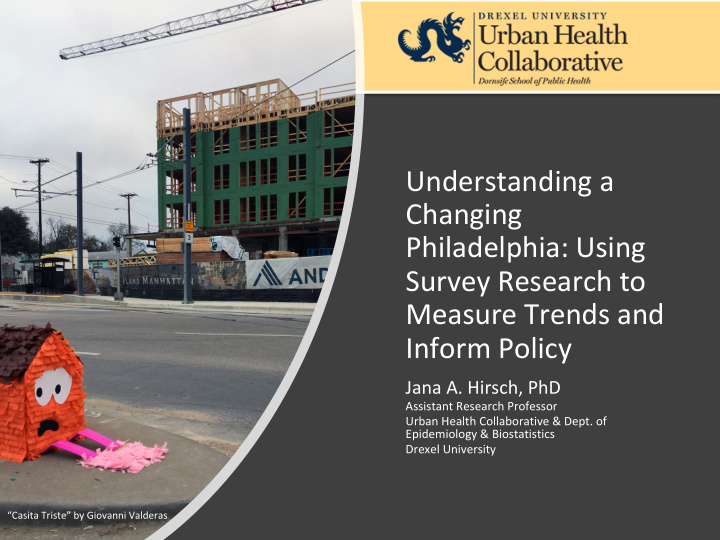



Understanding a Changing Philadelphia: Using Survey Research to Measure Trends and Inform Policy Jana A. Hirsch, PhD Assistant Research Professor Urban Health Collaborative & Dept. of Epidemiology & Biostatistics Drexel University “Casita Triste” by Giovanni Valderas
“Gentrification” • What does “gentrification” mean to you? THINK • Jot down neighborhood changes you associate with this term. PAIR • With the person sitting next to you, discuss your experience or understanding of “gentrification” SHARE • Share with the broader group. Pair and Share (2 min) Self-reflection Report back (1 min) (10 min)
History of the term “gentrification” • “Gentrification” first used in 1964 • Sociologist, Ruth Glass, • Neighborhood changes in London “One by one, many of the working class quarters have been invaded by the middle class-upper and lower. Shabby, modest mews and cottages—two rooms up and two down—have been taken over, when their leases have expired, and have become elegant, expensive residences…Once this process of ‘gentrification’ starts in a district it goes on rapidly until all or most of the working class occupiers are displaced and the whole social character of the district is changed” http://spitalfieldslife.com/2013/02/16/ the-haggerston-nobody-knows/
Shifting neighborhood dynamics • Severe disinvestment in mid 20 th century • Home Owners’ Loan Corporations (HOLC) • “Residential Security Maps” • Redlining • White flight https://philadelphiaencyclopedia.org/ archive/redlining/
Casita Triste Present day: New major infrastructure investments Centercityphila.org
Margo Reed (philly.com) Present day: New major service investments Iseptaphilly.com
https://pidcphilablog.com/opportunity-zones-philadelphia/ Present day: Policies around investment EIG.ORG (via Philly.com)
Flickr: MsSaraKelly Present day: Institutional pressures Alejandro Alvarez (Philly.com)
Academic definition of gentrification “Gentrification: a process by which disinvested areas experience reinvestment and an influx of more wealthy/educated residents” (Freeman, 2005; Hammel & Wyly, 1996; Bostic & Martin, 2003) • No consensus in definition • Gentrification ≠ Displacement
Operationalization of gentrification using publicly available data Census-based Non-census-based measures measures • Income • Green spaces • Education • Coffee-shops • Employment • External, structural renovation • Rent value/Home value • Commercial occupancy • Housing stock age • Discourse analysis
We need a new survey measure to: Detect changes in Measure More social/cultural perceived immediately environment changes capture changes to relevant resources
Perceptions About Changes in the Environment and Residents (PACER) Generate Question Scoping survey Edit/refine generation review items Cognitive NNIP expert Survey Edit/refine interviews Edit/refine input (n=28) (n=8) Survey PA NJ Edit/refine expert input AAPOR Community Cognitive Edit/refine input interviews Small BHP Full BHP Pilot Edit/refine sample survey
National Neighborhood Indicators Partnership (NNIP) Experts Survey Survey+CI Non-response
NNIP expert input: Online survey Content validity • Generalize beyond • Philadelphia
NNIP expert input: Cognitive interview Improvements to wording, clarity, and relevance to the experience of gentrification in specific city neighborhood
Domains of perceived gentrification Changes in Changes to Changes to amenities & physical affordability businesses environment Changes to General Feelings about social/cultural changes changes dynamics
SURVEY ACTIVITY Working together to improve PACER
THINK • Look at assigned domain. • Identify ways you would change each question. Things you feel are missing or duplicative. • Take some notes. PAIR • Share the edits you recommend with the person sitting next to you • Summarize your final set of edits SHARE • Share in your group. • Come to consensus. • Report back to the broader group. Pair and Share (5 min) Self-reflection Report back (5 min) (10 min)
Thank you!! Sharrelle Barber, Yvonne Michael, Leah Schinasi, Maura Adams, Najira Ahmed Keisha Miles, Share your name/email if Heidi Grunwald you’d like to stay informed about PACER!
References Barton, M. (2016). An exploration of the importance of the strategy used to identify gentrification. Urban Studies, • 53(1), 92-111. doi:10.1177/0042098014561723 Bostic, R. W., & Martin, R. W. (2003). Black home-owners as a gentrifying force? neighbourhood dynamics in the • context of minority home-ownership. Urban Studies, 40(12), 2427-2449. doi:10.1080/0042098032000136147 Ellen, I. G., & O'Regan, K. M. (2010). How low income neighborhoods change: Entry, exit and enhancement. • Freeman, L., & Braconi, F. (2004). Gentrification and displacement New York City in the 1990s. Journal of the • American Planning Association, 70(1), 39-52. doi:10.1080/01944360408976337 Freeman, L. (2005). Displacement or succession?: Residential mobility in gentrifying neighborhoods. Urban Affairs • Review, 40(4), 463-491. doi:10.1177/1078087404273341 Glass, R. (1964), Introduction: Aspects of Change. In: R. Glass, ed., London: Aspects of Change. London: MacGibbon • and Kee. Hammel, D. J., & Wyly, E. K. (1996). A model for identifying gentrified areas with census data. Urban Geography, • 17(3), 248-268. doi: 10.2747/0272-3638.17.3.248. Hwang, J, & Sampson R. J. (2014). Divergent pathways of gentrification: racial inequality and the social order of • renewal in Chicago neighborhoods. American Sociological Review, 79(4), 726-751. McKinnish, T., Walsh, R., & White, T. K. (2010). Who gentrifies low-income neighborhoods? Journal of Urban • Economics, 67(2), 180;193;-193. doi:10.1016/j.jue.2009.08.003 Papachristos, A. V., Smith, C. M., Scherer, M. L., & Fugiero, M. A. (2011). More coffee, less crime? the relationship • between gentrification and neighborhood crime rates in chicago, 1991 to 2005. City & Community, 10(3), 215-240. doi:10.1111/j.1540-6040.2011.01371.x Wyly, E. K., & Hammel, D. J. (1999). Islands of decay in seas of renewal: Housing policy and the resurgence of • gentrification. Housing Policy Debate, 10(4), 711-771. Zukin, S., Trujillo, V., Frase, P., Jackson, D., Recuber, T., & Walker, A. (2009). New retail capital and neighborhood • change: Boutiques and gentrification in New York City. City & Community, 8(1), 47-64. doi:10.1111/j. 1540-6040.2009.01269.x
Recommend
More recommend